Old Macdonald
Oregon, United States of America
Green Keeper: Ken Nice

Interpretations on classic design elements find a new home at Old Macdonald. Above is the sixteenth green as taken from on top of the Alps hill. A bell hangs from the post in the background for golfers to ring as they clear the green.
When Chicago Golf Club opened in 1895, Charles Blair Macdonald had every reason to be proud as he had designed an eighteen hole golf course in a country that had few of them. Thanks to his time at St. Andrews, he had gained a good understanding as to what constituted great golf. As he continued his travels back and forth to the United Kingdom, he developed and refined his thoughts on architecture. By 1906 – in part thanks to hiring Seth Raynor as a project engineer – Macdonald was much better able to translate his ideas into the dirt than his first effort at Chicago Golf Club. One result was his masterpiece National Golf Links of America which opened for play in 1910 and was followed by other courses of great quality including Lido Golf Club. Macdonald became a central figure in shaping the evolution of golf in the United States and he is commonly referred to as the father of golf course architecture in America.
Roll the clock forward one hundred years and there are now four hundred plus competent architects around the world, a few of which are building golf courses as grand as any that have ever been done. Rather than a paucity of talented golf course architects, what is more scarce today is great land for golf mirrored with owners who will act as good land stewards and who will put the golf first. Few it seems enjoy the clarity that Macdonald possessed as to what makes great golf.
As of 2010, one man has differentiated himself from all others that build golf courses as his name is now tied to more world class courses built since World War Two than any other. That man is Mike Keiser who owns the wildly popular Bandon Dunes resort that caters to the public with its four courses as well as having helped back the golf at Barnbougle and Lost Farms in Tasmania. With well over one hundred and twenty thousand rounds expected to be played on one of these six golf courses in 2010, his sure-footed continuation of creating golf courses that inspire and invigorate people to enjoy the sport has conferred upon him populist influence that is unmatched in the game today. And at Old Macdonald, the two central figures at the beginning and end of the twentieth century have come together to yield a special course.
As the success of the Bandon resort roared on from one to two and then three courses, a fourth became a genuine consideration. This form of dream golf as envisaged by Keiser, of man out in the elements battling nature, had proven popular beyond imagination with no sign of abating. Hence, the most asked question in golf architecture was what kind of course Keiser might want and which architect he would select.
Living in Chicago, Keiser had long enjoyed an admiration for Charles Blair Macdonald, based on his own exposure to Macdonald and Raynor’s work at Chicago Golf Club and Shoreacres as well as Keiser’s own extensive travels. In 2005, with plenty of land still at his disposal at Bandon, Keiser had George Bahto, the world’s lead Macdonald scholar, draw up an eighteen hole plan on three hundred plus acres at the northern end of the resort that replicated Macdonald’s famous Lido course on Long Island which had fallen victim to the Great Depression. With Macdonald’s work having stood the test of time so well, why not borrow some of his favorite design concepts? Paying homage to the most time tested design principles in golf course architecture was not folly (folly could have been considered building Bandon Dunes on a remote part of the Oregon coastline in 1996 when your friends said you were crazy!).
As this notion began to crystallize in Keiser’s mind, he determined not to do a slavish copy of Lido as that would be a disservice to the natural features of this particular Oregon coastal property. Nor was he after eighteen holes that were rigid copies of either the originals or of the template holes as built by Macdonald and Raynor at their other courses. Rather, he was keen to replicate the strategic dilemmas that these famous holes posed while building them in a manner consistent with the rugged, sandy nature of the property with which he had to work.
To build the holes, he elected to go back to Tom Doak and his Renaissance Design team. Obviously, Keiser’s interaction with them had yielded a wonderful result at the bordering Pacific Dunes. More importantly, Tom Doak and co-designer Jim Urbina had a plethora of work experience on many of Macdonald and Raynor’s finest courses including Mid Ocean, Yeamans Hall, Camargo, Shoreacres, The Creek and Chicago GC. There was no team better prepared to adopt Macdonald’s principles into the ground than Renaissance.
Initially, much of the land was shrouded in gorse but as the thick, dense vegetation was pulled back some startling landforms that were three to eight feet tall (which are ideal for golf) were found underneath. Despite being the fourth course built on the Bandon property, the land and its characteristics were most assuredly not the fourth best. Indeed, debate as to which of the four courses enjoys the best property from which to build a course is a matter of ongoing debate. Each property has its own defenders, be it the diversity of Bandon Trails to the number of cliff side holes afforded at Bandon Dunes to the sandy blowouts at Pacific Dunes and now the rippling land features, scale and long views at Old Macdonald.

The long, uninterrupted views at Old Macdonald will remind many of some of the great courses in Scotland that inspired Macdonald, such as North Berwick and St. Andrews.
Many of the template holes that Doak and co-designer Jim Urbina chose to use were obvious. The four short holes were the classic Macdonald/Raynor set of Short, Eden, Redan and Biarritz. The Long hole after the fourteenth at St. Andrews was a must as was the Road hole. The most famous holes that existed in Scotland and England when Macdonald was making his trips there were to be included, namely the Sahara at Royal St. George’s (a short par four that bent left to a blind green in a dell), the Bottle hole at Sunningdale (a stout par four where the fairway bunkering narrows down the hitting area off the tee) , the Alps at Prestwick with its famous blind approach shot over a dune to a tightly defended green) and the Redan at North Berwick (perhaps the most copied hole of all featuring a high right to low left green set on a 45 degree angle from the tee). Other holes made famous by Macdonald and Raynor such as a Double Plateau and Maiden greens were to be included if possible.
In a tribute to Doak and Urbina’s ability to route a course, all these famous holes made it in. Even more important, each of the holes sits so well upon the land and makes it look as if any other type hole would have been a poor substitute. One may lament the absence of a Knoll hole (indeed there was one in Doak’s first two routings but it was dropped when the decision was made to build the seventh green atop the dune line which opened up the creation of the Biarritz green in approximately the same place where the Knoll green would otherwise have been) but otherwise, this collection of type holes is as impressive as any collection that Macdonald and Raynor ever assembled.
For students of golf course architecture, a trip to the public access Bandon Dunes resort is as rewarding as any they can make. After all, Macdonald and then Raynor primarily built courses for elite private clubs and the opportunity to see their best work is limited. The opening of Old Macdonald on June 1st, 2010, one hundred years after National Golf Links of America opened, changes all that. Perhaps the opportunity to see such classic strategic dilemmas will inspire a new wave of interest in golf course architecture? Maybe the next Brian Slawnik or Eric Iverson or Brian Schneider will emerge from the experience of coming to Bandon.
However, rest assured: The primary goal at Old Macdonald was to create a series of arresting holes that fit the land and that people will enjoy playing. If they become inspired to delve into the subject of golf course architecture, all the better but, as with the other three courses at Bandon, it is all about the quality of the golf and the shots that you are going to be asked to hit/invent.
As we see in the yardages given below, the length that Old Macdonald can be played ranges from just over 4,200 to almost 7,000 yards. Regardless of the yardage selected, the common theme is that the golfer is unlikely to lose a golf ball. As such, with the possible exceptions of Yeamans Hall where Doak and Urbina have worked for years and Pinehurst No.2, the author can’t think of a single course more conducive for a grandfather, father, wife and child to play than here. Forced carries are at a minimum while the amount of acreage presented as short grass is at a maximum for any course built since World War Two.
Holes To Note
First hole, Double Plateau, 340/215 yards; At around 255,000 square feet, the greens at Old Macdonald are far and away the largest set in the United States, dwarfing all others, and they provide the course with an unusual amount of flexibility in course set-up. Take the first green for instance. If the hole location is on the front left plateau, the hole will likely play a full stroke harder than one found in the middle part of the green. Similarly, a hole location on the back plateau that bleeds away to the rear is at least half a stroke more than the ones in the middle. Pressure in turn now shifts to the green keeping staff in selecting the day’s hole locations and getting the right mix of hard and easy ones. The smooth transitions throughout this monster Double Plateau green is a prime example of how Keiser picked the architects: Doak and Urbina were coming off of restoring Yeamans Hall’s own Double Plateau with spectacular success when this project commenced and clearly what they learned in South Carolina carried over here.
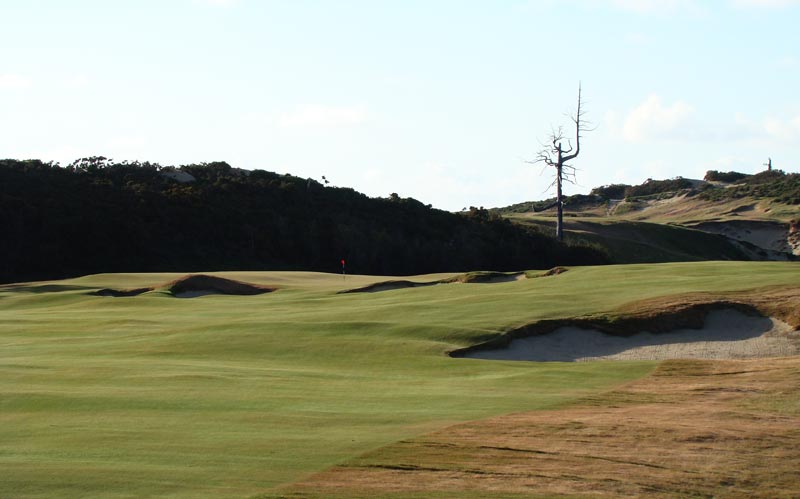
The width of its fairways and size of its greens provide playing angles galore, something that most golfers aren’t accustomed to. Part of the fun is how many rounds it will take to learn how to play best each hole in certain wind conditions. For instance, when the flag is on the front left plateau, many a golfer might decide the best angle is from the high right portion of the fairway.
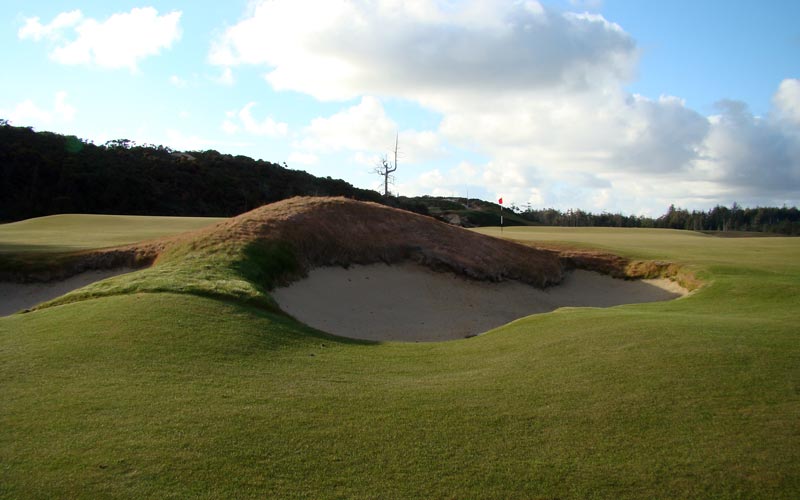
One of the most elastic features on a Macdonald course is the placement of the Principal’s Nose bunker, ranging anywhere from 160 yards from the green as at Chicago Golf Club to much closer in to a Double Plateau green. At Old Macdonald, the architects opted to use it as a greenside bunker.
Second hole, Eden, 180/100 yards; Some hunches pay off and some don’t but Doak’s did regarding the landform that became the second green. It had two characteristics, first it was wide enough to serve as the basis for the Eden green which is nearly twice as wide as it is deep and secondly, the backdrop wasn’t for hundreds of yards in the distance. Macdonald’s own adaptation of the Eden at St. Andrews was his weakest copy at National Golf Links of America. An unintended consequence of that is that Raynor, who never went to Scotland himself to study the original holes, perpetually never built enough back to front slope in his Eden greens to properly create the ‘tension’ (as Desmond Muirhead termed it) between the green slope and the penal Strath bunker. Doak and Urbina successfully rectified that shortcoming here. Of course, the very definition of a slow start to one’s round is finding yourself on the opposite plateau at the first from where the hole is followed by dumping your tee ball into Strath bunker at the second – woe is that golfer!
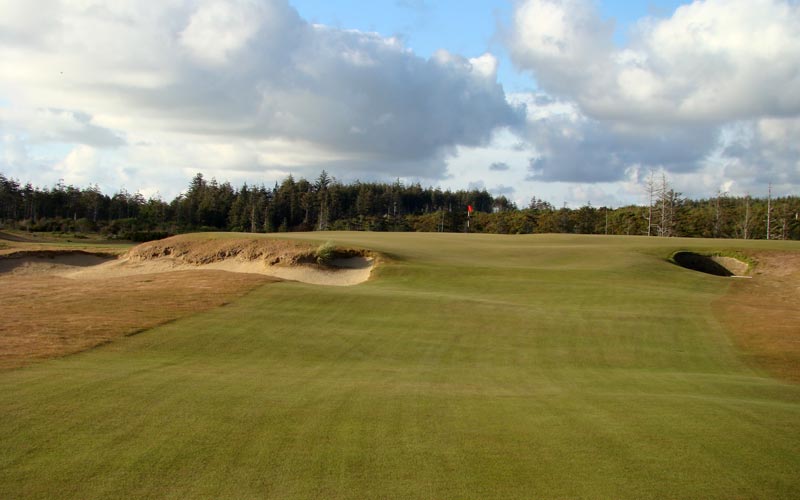
The Hill bunker loops around the left and back of the Eden green and a miss long left is a definite no-go. However, it is the deep Strath pot bunker to the right coupled with the steep back to front nature of the green that creates the most perturbing hole locations.
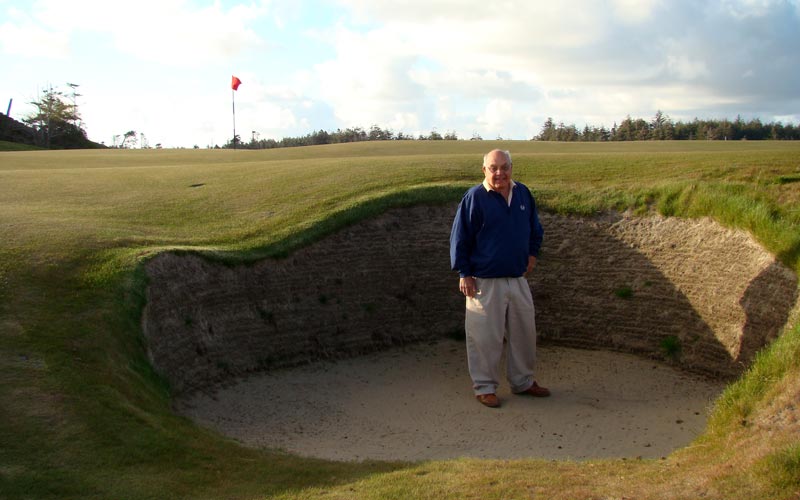
Mike Keiser has done many, many things right in the world of golf and one of them was having George Bahto consult on the construction of Old Macdonald. As seen above, tee balls that finish anywhere near Bahto’s feet leave a recovery shot whereby the golfer desperately needs to get the ball elevated quickly in order to escape Strath bunker in just one blow.
Third hole, Sahara, 375/215 yards; One inherent challenge in building template holes is that they invite direction comparison to the original ones, which were generally of alarming excellence or they would never have become template holes to begin with! In this case, the Sahara at Royal St. George’s was a personal favorite of Bernard Darwin and one of the most famous holes in England up until it was altered in the 1970s in the mistaken pursuit of placating the modern player. Just listen to how Darwin described it: When a name clings to a hole we may be sure that there is something in that hole to stir the pulse, and, in fact, there are few more absolute joys than a perfectly hit shot that carries the heaving waste of sand which confronts us on the third tee. The shot is a blind one, and we have not the supreme felicity of seeing the ball pitch and run down into the valley to nestle by the flag. We see it for a long time, however, soaring and swooping over the desert, and, when it finally disappears, we have a shrewd notion of its fate. Despite the original’s outstanding reputation, this one may be even better with its blind drive from the back markers needing to first clear a fearsome fifty foot deep sand pit before playing to a large, free flowing green that emerges from the base of the dune on the far side.
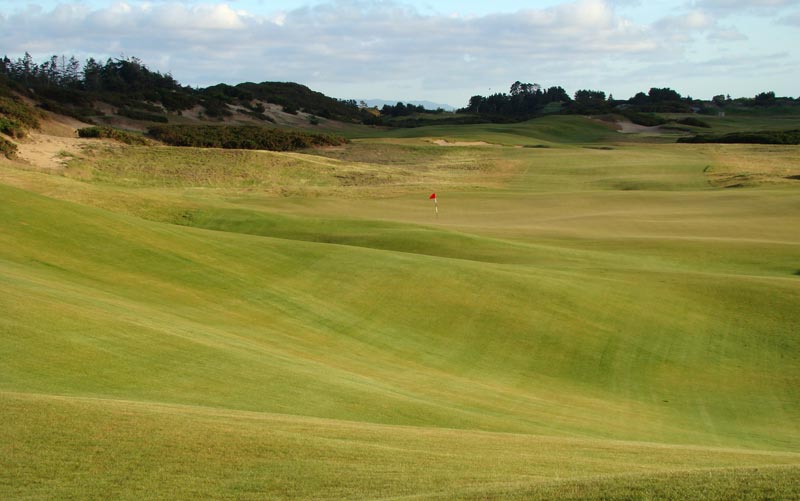
When the flag is tucked all the way left against the dune, the golfer needs to drive right and toward the outside of this dogleg left in order to gain the best shot in.
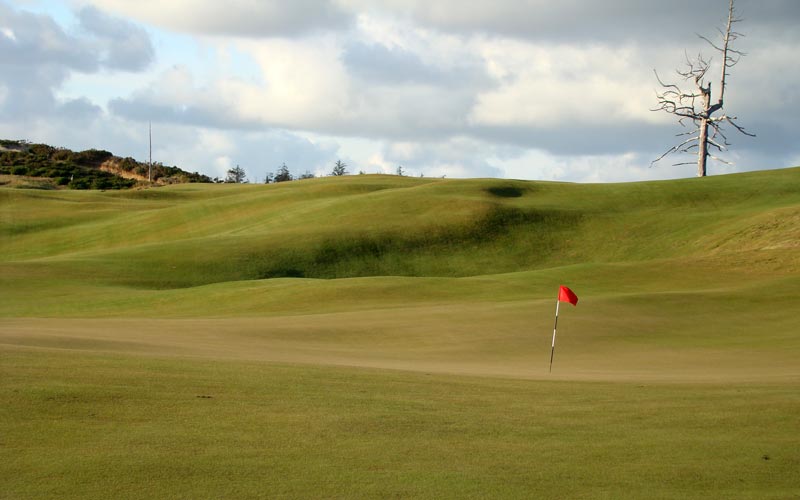
The tumbling nature of the third fairway is captured in this view looking back up the hole. The rolls and hollows appear natural, which is a great compliment to the skill of the Rennaissance crew who built the course and includes Bruce Hepner, Kye Goalby, Brian Schneider, Eric Iverson, Brian Slawnik, Mike McCartin, and Jonathan Reisetter). The challenge was in seamlessly transitioning from the top of the dune to a green in the flat below and they accomplished it with apparent ease.
Fourth hole, Hog’s Back, 505/ 285 yards; There isn’t a particular Hog’s Back hole in the United Kingdom but the concept of a ridge that sheds balls both left and right and that runs parallel down a long wide fairway is found on many courses. In fact, one of the best modern versions is found just down the road at the fourth hole at Bandon Trails. Here, the golfer ideally seeks to have his ball stay atop the ridge and thus gain the best view of the green. To accomplish that requires the most exact drive on the course, despite this fairway being over eighty yards (!) wide. Doak’s visit to Scotland in 2008 with George Bahto and their tour of the seventeenth hole at Lundin Links reminded him again of what a fan he personally is of this design concept and his design at Ballyneal employs this strategy within several fairways to great success.
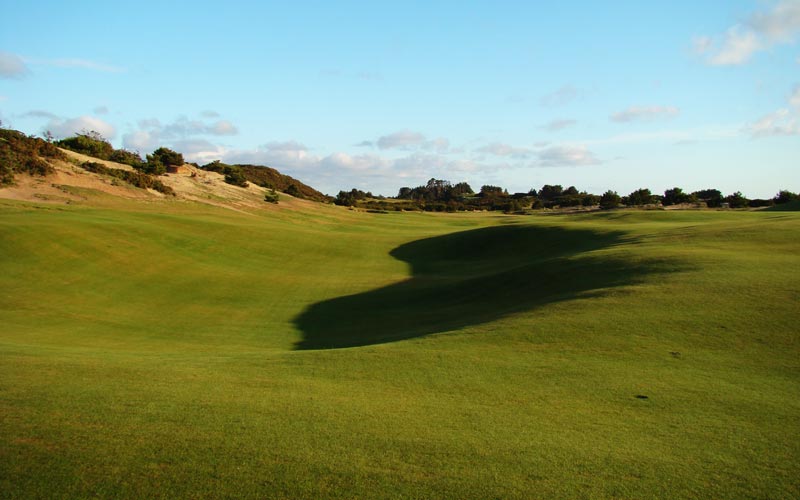
Tee balls tugged left take the Hog’s Back slope in the fairway and are pushed all the farther left. Conversely, …
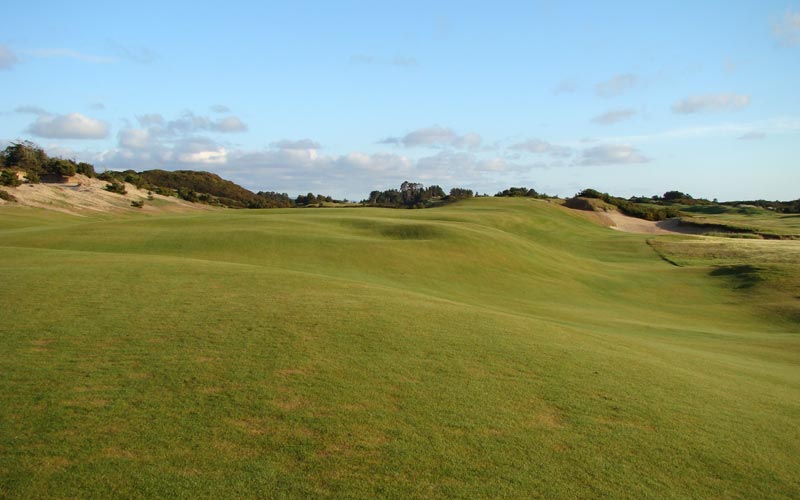
… tee balls that drift right are shunted toward the menacing right fairway bunker. Best of all is the playing angle/stance, and view afforded …
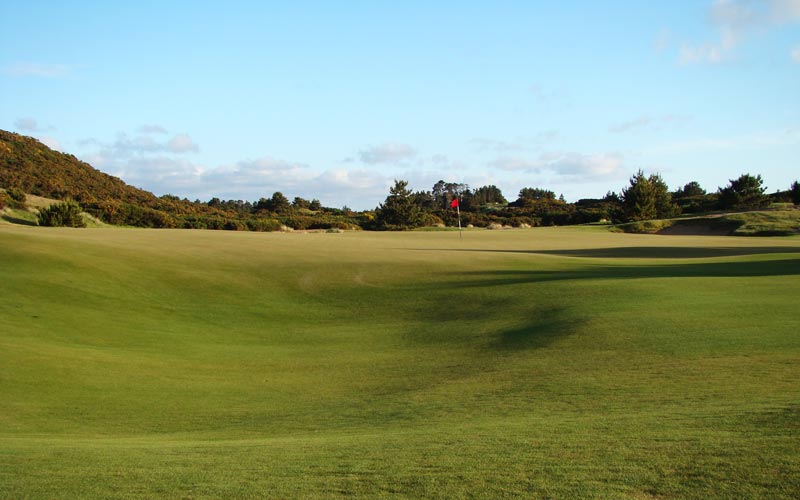
The construction process of Old Macdonald was over a three year period with all the key decisions occurring in the field. This slow process of evolution suits Keiser perfectly as there is time to mull over options. One such example occurred here at the fourth green where a greenside bunker was initially placed left of the hollow above. With time, the decision was made on this long two shotter that either into the wind or downwind the hole played better without it. The bunker was removed and the hole is better for it.
Fifth hole, Short, 160/100 yards; Macdonald was quite taken by the one shot fourth hole at Royal West Norfolk and when it came time to build National Golf Links of America, he added the twist of a wild green to that of a forced carry. This rendition has both characteristics with the right bunker the most pernicious greenside hazard on the course and the green itself looking like the sister to Alister Mackenzie’s eye-popping sixteenth green at Sitwell Park. Similar to other courses with large greens such as The Old Course at St. Andrews and Yale, hitting the green in regulation is but the start. Good players may well hit fourteen greens and still not break 80 if they don’t position their approach shots correctly.

As seen from the right, the fifth green measures over 18,000 square feet and falls more than nine feet (!) from back to front. Even such statistics fail to convey its dramatic playing nature. One player remarked upon walking up to it that the green felt like a series of waves coming at him.
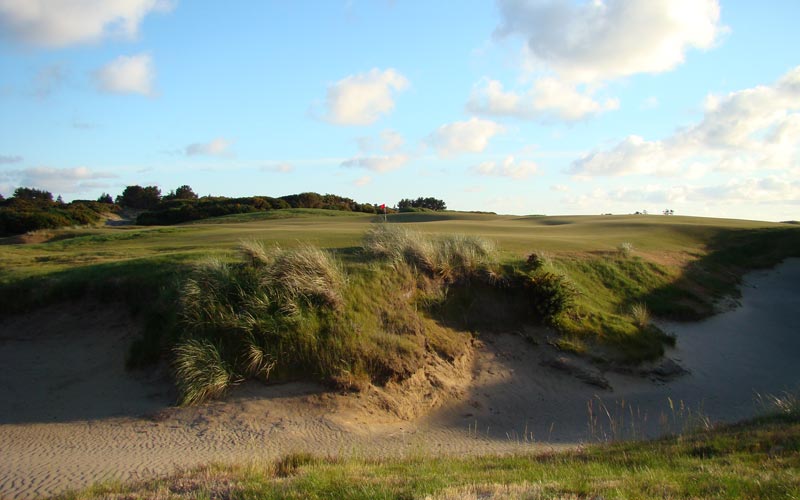
Fair for a hole named Short, not only is the green challenging but the course’s most striking greenside hazard is also found on this hole.
Sixth hole, Long, 555/355 yards; What do you do as architect when you come to the only flat portion of the property? You want to use the land so that the next hole can go up into the dunes but how do you knock character into it to allow it to stand up with the rest? The answer is that you manufacture one of the world’s most famous hazards (the Hell Bunker as found at the Long Hole at St. Andrews) as well as one of the course’s best greens. In addition, the subtle contours that Urbina painstakingly built into the fairway make the bunkers left off the tee play much bigger than their actual footprint. Tee balls hit with a slight draw may land thirty yards away but have a mysterious way of ending up in these bunkers, from where carrying Hell Bunker in two is out of the question. Though much of the initial commentary centers on Old Macdonald’s vast scale, it’s this kind of finesse dirt work – of these twelve to twenty four inch rolls in the fairway – that allows the actual playing of Old Macdonald to live up to the intrigue provided for over a century by some of the orginal template holes.
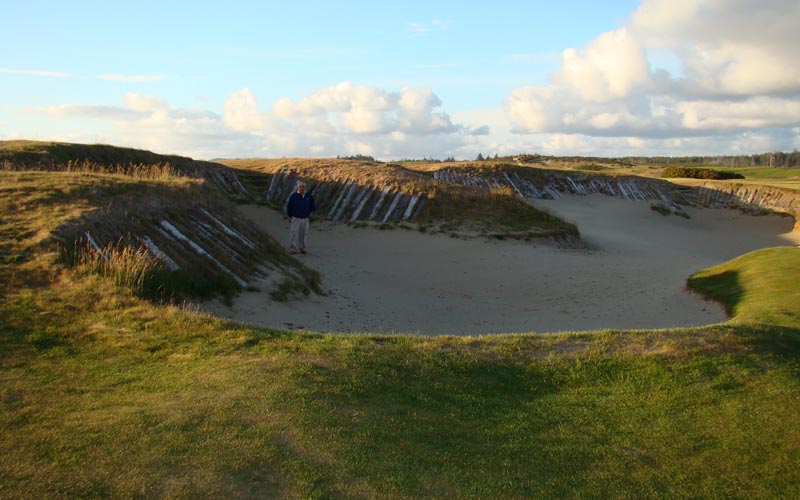
Perfectly placed 100 yards short of the green, this fearsome rendition of Hell Bunker dominates the second shot requirements. Note its depth versus the height of George Bahto.
Seventh hole, Ocean, 365/195 yards; Some of the best holes at National Golf Links of America are Macdonald’s own original creations (e.g. the first, tenth, and fifteenth holes). No doubt some golfers will list this hole which has no precedent among their favorites at Old Macdonald. It starts with a scintillating blind drive over some hummocks to a wide fairway before climbing uphill to a green site that provides a fine place to contemplate one’s stake in life. Finding this green is a must as self pity will sweep over the man whose approach comes up short and rolls well back down the hill as well as the man whose approach goes long and finds a punishing back bunker.

A neat tee shot over a couple of hummocks sets the golfer up nicely for the attractive uphill approach.
Eighth hole, Biarritz, 180/120 yards; The first time a golfer plays to a Biarritz green is an unforgettable experience. Even from this elevated tee, the uninitiated can’t quite process what it is that he is looking at as there appears to be something that runs through the middle of the green. Closer inspection shows it to be trough or swale that is over three feet deep in spots. The hole location determines the challenge: If the flag is on the front plateau, the golfer needs to have his tee ball stop before it disappears down into the swale. If the hole location is on the back half, the golfer needs to make sure that his ball motors on past the swale and up onto the back plateau. Either way, the elevated tee gives him the perfect spot to watch the action unfold.
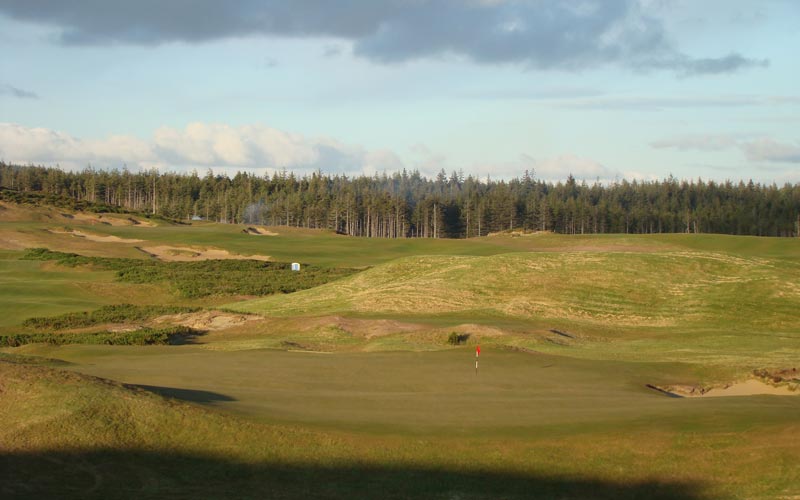
The view from the eighth tee shows an immense green that seems simple to hit. Here, the indentation through the middle of the green provides both the fun and the challenge.
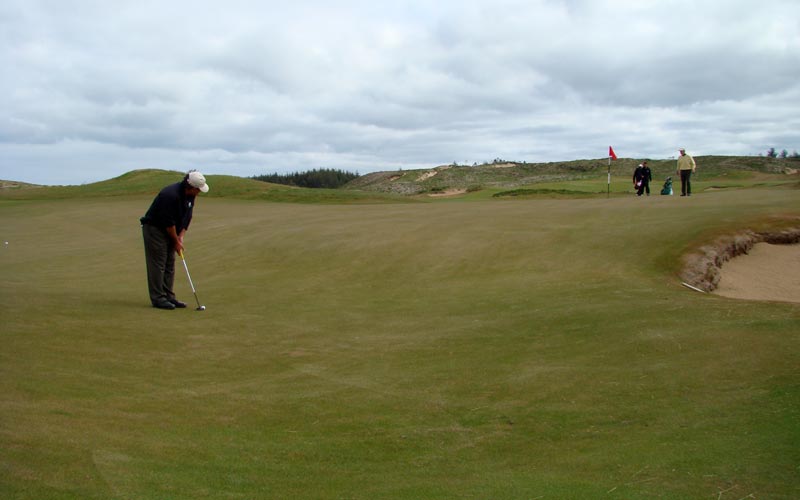
The flight of this golfer’s tee ball was too high and his ball landed too soft to chase onto the back plateau, making it just a question of time before he registered another sad three putt. Unlike the famous swale at Yale, this one isn’t as rigid and linear which is in keeping with the free flowing nature of the property.

This view from across the fifteenth fairway shows how the golfer climbs up to the seventh green before playing back down to the Biarritz green.
Ninth hole, Cape, 415/230 yards; The best Cape holes (the fifth at Mid Ocean, the eighth at St. Louis, the fourteenth at National Golf Links of America) feature a water hazard upon which the hole pivots around. Such all or nothing hazards provide intense interest that the bunkers and vegetation on the inside of this Cape hole don’t match. Conversely, the bunkers and gorse here better tempt the golfer into being greedy, making this version a delightful hole to play time and time again.

The array of hazards along the inside of this Cape hole mete out punishment that varies, which is a most appealing characteristic for a hazard to enjoy.
Tenth hole, Bottle, 465/325 yards; The fairways at Old Macdonald are among the widest in the game (in fact, they may well be the widest as they frequently range between sixty and eighty yards in width). Yet, width for no purpose serves no purpose so the only reason these fairways make sense is because of the hazards that are found within them, be it bunkers like Hell or landforms like the Hog’s Back. Here at the tenth, two true fairway bunkers (i.e., bunkers surrounded by fairway, which is uncommon in the United States) create confusion from the tee as to which is the best direction to go within the fairway. As this hole normally plays downwind, the fearsome greenside bunker that it shares with the fifth hole is a real worry for approach shots that go long. Given how steep the bank is that leads up to the tenth green, one is surprised to find that a running approach shot might actually be the best play. Again, the luxury of a running approach is afforded from the benefits of working with sandy soil, the type of fescue blend that the Oregon climate accommodates, the skill of Doak’s crew in shaping the transition areas from fairway to green and Ken Nice’s ability to make the playing surfaces play fast and true. All these factors give the golfer appealing shot options, both on his approach and recovery should his approach go awry! Like its counterpart at the eighth at National Golf Links of America, this green complex may well expose deficiencies in one’s short game with terrifying condescension!

What a refreshing sight to see: Fairway bunkers directly in the line of play. Unlike so many modern architects, Macdonald fully appreciated the lesson learned from studying the placement of such bunkers at The Old Course at St. Andrews.
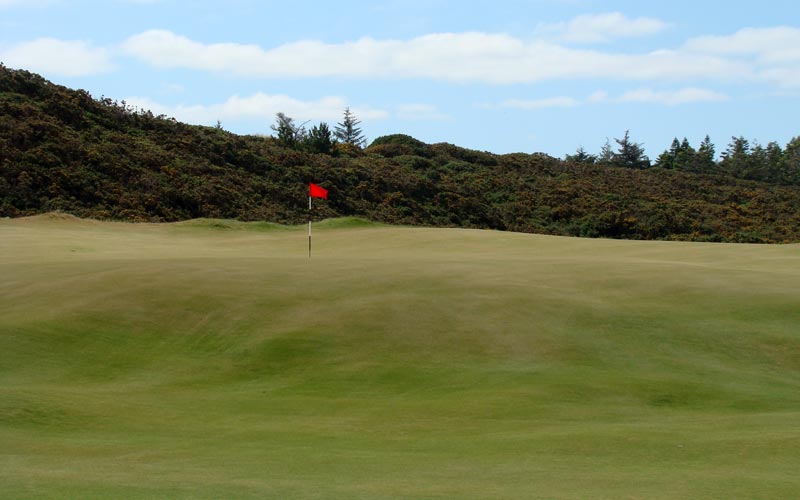
One of the toughest approach shots at Old Macdonald is to the elevated tenth green. As seen above, trying to stop a ball downwind anywhere near this hole location is vexing. Good golfers are scared by the sight of so much short grass as they appreciate how easy it is to take three – as opposed to two – shots from the base of the green. Meanwhile, the weaker golfer delights in taking three shots and quickly moving on.
Eleventh hole, Road, 445/315 yards; Played back into the wind; this Road hole presents the likely need to hit a similarly lengthy approach as to the famous one at St. Andrews. All the playing angles are beautifully replicated and the player needs to flirt with the bunkers down the right off the tee to have any sort of decent angle into the narrow, angled Road green. Macdonald sniffed that the Road hole at St. Andrews was ‘easy to duplicate’ when he built National Golf Links of America but his own Road green lacks the subtle playing terrors that this one possesses in spades. Some critics are already deeming it to be the best Road green complex built since the original.
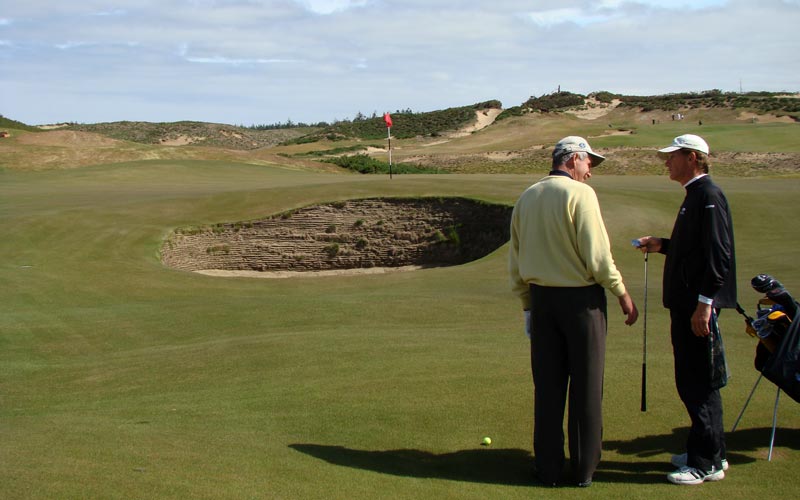
The classic conundrum: The player’s approach has come up short into the wind and the Road bunker is now between his ball and the hole. Modern wedges with more loft and minimal bounce give the golfer another shot to consider that didn’t exist in Old Tom Morris’s day. Still, all the player can do is offer a rueful laugh.

The ground around the Road bunker was carefully massaged and its gravitational pull is large. Balls feed into it, even from on the green!
Twelfth hole, Redan, 235/90 yards; Though more like a Biarritz in length, this Redan plays truer to the length of the original one at North Berwick as it plays downwind during the busy summer months. Hence, this lengthy version puts more focus on the ground in front of the putting surface than any other version with the possible exception of the Redan at the Country Club of Fairfield.

How to use the slope that feeds up onto the green as a brake for a drawn shot downwind will prove to be endlessly fascinating.
Thirteenth hole, Leven, 345/220 yard; As at Pacific Dunes, the golf is so compelling that the golfer barely notices the unconventional nature of where the pars fall. At Old Macdonald the second nine is over eight hundred yards longer from the back markers though the par is 37 compared to a par of 34 for the first nine. This came to pass after Doak’s third routing in which the push was made to create the saddle green at the seventh which in turn lead to creation of the Biarritz (i.e. a third one shotter on the front offset by only one three shotter). Regardless of where the pars fall, one theme is constant throughout and that is when there is a penal hazard, the golfer is given a corresponding amount of room to work around it. Also, let’s not take for granted just how good the ground is for golf in this section of the property. Yes, we are away from the ocean and it is hidden from view but as co-designer Jim Urbina noted in his March 2010 Feature Interview on this site: Contrary to Pacific Dunes, Old Macdonald had some of the choppiest land out in the flats. When you look at the land from afar it looks very soft but when people walk out and see each hole you will see nice little rolls and features that you won’t see on most links land. Hole 13 at Old Mac is a good example. I would take 200 acres of this kind of land it would be really fun to create 18 holes out of this type of dune formation. Looks flat compared to the surrounding dunes but far from it. I have always talked about the grand scale of Old Macdonald and most people will see why but in contrast it’s the small contours that I appreciate the most.

This photograph of three bunkers clawing into the thirteenth green only tells half the story. To the left is a large hillock and the green swoops down dramatically from left to right off it. Approach shots can be feed to all corners on the green by using the ground contours.
Fourteenth hole, Maiden, 370/230 yards; Macdonald liked naming holes and by doing so he helped well traveled people better understand what they were seeing and playing when golf was still in its early days in the United States. Conversely, Raynor left others to name his holes and the name Maiden was bequeathed to his holes that feature high left and right plateaus with a gulley between them (his Maiden holes have nothing to do with the blind par three Maiden hole that once existed at Royal St. George’s). Such is the case with the fourteenth green at Old Macdonald with an added benefit that the dune behind the left plateau acts as a backstop and helps bold approach shots roll back onto the left plateau.
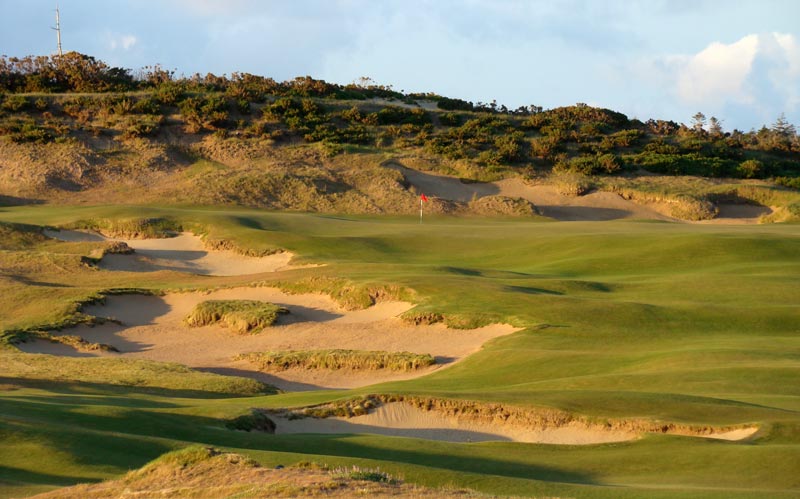
Given that it’s a windy site, how the hole corridors tack and bend are important so that there is never a stretch of holes that feel like a slog into the teeth of the wind. Here the fourteenth bends left around an impressive bunker set before rising to a green with high plateau left and right.
Fifteenth hole, Westward Ho!, 535/340 yards; As with most links found in the United Kingdom, the preponderance of holes at Old Macdonald don’t afford views of the ocean because of the imposing dune line that runs down the coast. Similar to what the golfer finds at Seminole, the best vantage points are on the greens and tees located on the coastal dune line or by the holes located on the inland dune line that runs parallel. Though it is seven hundred yards from the coastline, the fifteenth tee perched high on the inland row of dunes presents one of the most magical spots of any of the four courses at Bandon. Thirteen flags on Old Macdonald can be made out in the valley between the two dune lines and the golfer soaks up the purity of the landscape, unmarred by man.

In keeping with the vast scale of their surrounds, the bunkers down the right of the fifteenth are among the largest hazards on the course. Small or chopped up hazards dotting the landscape would have looked woefully out of place/proportion.
Sixteenth hole, Alps, 455/270 yards; One of the fascinating aspects of National Golf Links of America is how Macdonald interpreted certain features from classic United Kingdom holes and incorporated them into his holes in the United States. For instance, with the Leven, he turned one of the landforms perpendicular to how it was at Leven Links in Scotland and walled off the seventeenth green at National Golf Links of America. In regards to the Alps, the one at Prestwick became famous in part because of its uncompromising nature. Not only does the golfer have to carry a tall hill with his approach shot but there is a hidden deep bunker that walls off the front of the green as well. Doak and Urbina’s interpretation of the this superb hole is more strategic and in keeping with the one at National Golf Links in that the golfer talented enough to hit a drive long down the right can often times get a good look at the day’s hole location.

Coming in from the left, note how the Alps hill doesn’t extend across the entire fairway. That means …

…that approach shots played from the far right of the fairway can actually enjoy good looks at many of the hole locations.

Seventeenth hole, Littlestone, 545/345 yards; The only water hazard on the course is found here and is only in play for those seeking to reach this green in two by taking the short way home. In conjunction with the small wetland area right off the tee, the intimidating sleepered bunker that walls off the left of the green creates multiple playing angles on this reachable par five. Though the small ‘puffs’ in the deep green lend the hole true character, it is the use of railway ties for the second time on the course that captures the eye. Indeed, looking back, the course has an astonishing array of bunkers, ranging from some pots to the sand pit off the third tee to blowouts down the fifteenth to three sleepered bunkers as well. Leave the final word on that to Macdonald himself who wrote In Scotland’s Gift in 1928 that, To my mind, an ideal course should have at least six bold bunkers like the Alps at Prestwick, the Ninth at Brancaster, Sahara or Maiden (I only approve of the Maiden as to bunkering, not a hole) at Sandwich, and the Sixteenth at Littleton (sic). Such bold bunkers should be at the end of a two-shot hole or a very long carry from the tee.
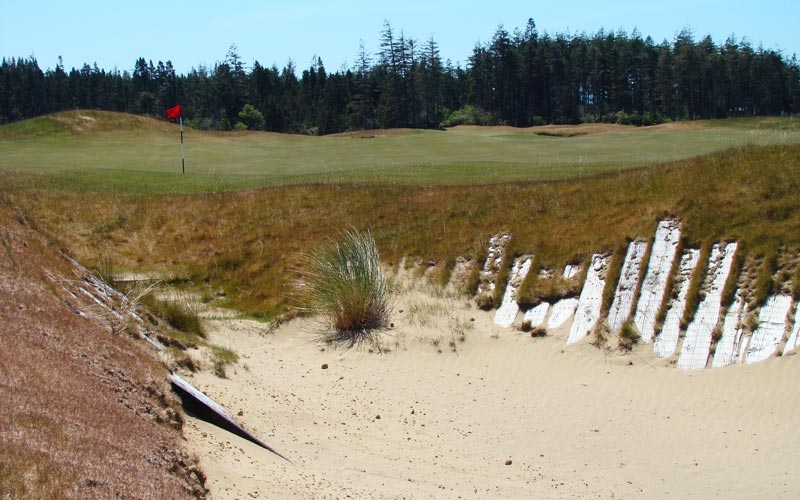
By the time that play officially commenced, Old Macdonald already enjoyed a timeless quality to it. The sleepered bunker and angled green creates the axis from which the rest of the hole revolves around.
Eighteenth hole, Punchbowl, 470/310 yards; At this stage, the golfer has likely determined that he has never played a course remotely like it, certainly not in the United States. What feature could provide a fitting conclusion for such a unique course? The answer is a Punchbowl green of which there are so few. This bold type green caps off the best hole at two of Raynor’s courses (Chicago Golf Club and The Creek Club) and so the bar was raised high when the crew at Renaissance Design decided to tackle a Punchbowl green of their own. Just like the rest of the course, this one is so audacious in scale and so fun to play that the golfer has no desire to leave it even once he has holed out. At over eighteen thousand square feet, it is large enough to be a practice green with eighteen hole locations and if it was, it would be as fun as any practice green in the world. Hitting putts around this green and seeing how to use the banks and walls and ridges to get balls to stay in various portions of the green is as enjoyable as it gets.

No better way for the course to end than with this monster Punchbowl green as it sweeps from high left to lower right.
Not unlike Sand Hills in Nebraska, Old Macdonald is so different from anything else that it will be interesting to see what – if any – influence it will have on the direction of golf course architecture. The strength and flexibility of its golf holes insures that it will continue to garner glowing critical reviews while also putting smiles on the faces of many recreational golfers. And that’s a winning combination for both the owner and the player, something that the game hasn’t seen a lot of lately.
It also begs the question as to what pressure Old Macdonald will put on other household name resorts who are now far behind Bandon’s pace of possessing four world class golf courses. Most high end resorts only have one, if that. Just as Macdonald learned from touring the great courses in the United Kingdom, when will other resort owners start borrowing a page out of Keiser’s book for building successful, thriving golf courses?
There are certainly lessons to be learned from Keiser’s approach at Bandon. He bought great property and unreservedly set aside the best parts for golf while focusing on the recreational golfer to have fun and enjoy himself. (the caddy program, which is the healthiest in the country, helps to that end). The beauty of each of the courses is self evident but Old Macdonald would have really been marred visually if cart paths existed or if town homes had been constructed along one of its tall dune lines. Mercifully, Keiser opts instead to put the golfer out in nature alone to do battle with the elements and manmade structures do not hamper or intrude on one’s game. Keiser continues to bet on golf as a sport (not as a real estate development) and has been handsomely rewarded for doing so. The fact that he continues to be such a responsible land steward while at the same time guiding a profitable business enterprise highlights that the two events are not mutually exclusive.
Another lesson that other people who build golf courses could learn is how Keiser uses several different architects. Yes, he hired Renaissance Design to build two of the four courses but they are one of the few firms talented enough to build two courses side by side and yet the golfer has no idea that the same firm built both. The scale of Pacific Dunes and Old Macdonald is different and reflects their respective sites, the bunker style is different, and the green complexes are wildly different. No one could fathom that the group that built such vicious green complexes that play small such as the sixth, fourteenth, and sixteenth holes at Pacific Dunes would also be responsible for the mammoth greens at Old Macdonald. The distinct aesthetic and playing differences between the four courses act as an allure as there is something to suit a wide range of tastes.
The only pity about Old Macdonald? That its three sister courses are world class and rare will be the golfer who books a five day trip to the Bandon Resort only to play and study Old Macdonald. With its fairway width, bunkers in the line of play, and the scale of its greens, this course possesses variety unlike any other in the United States as its engaging challenges change daily based on the wind and the day’s hole locations. As with The Old Course at St. Andrews, just one or two rounds do not begin to suffice for learning the course’s charms. The golfer will delight in playing the course again and again – and again! At the end of the day, is there any higher compliment?
The End




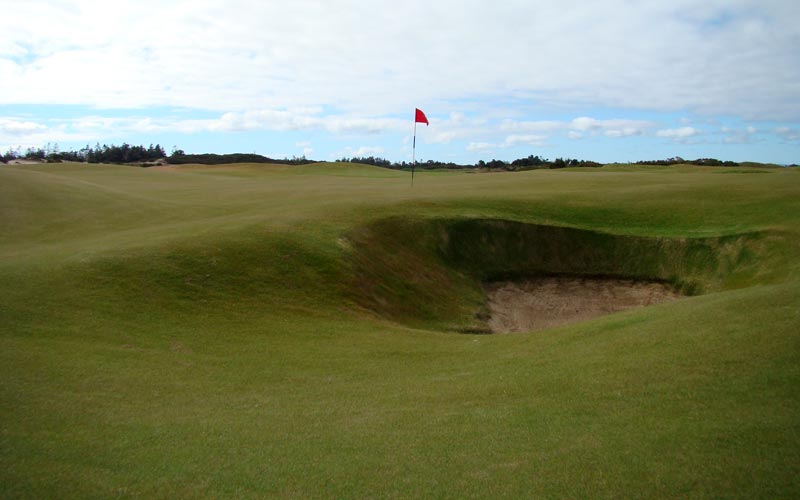
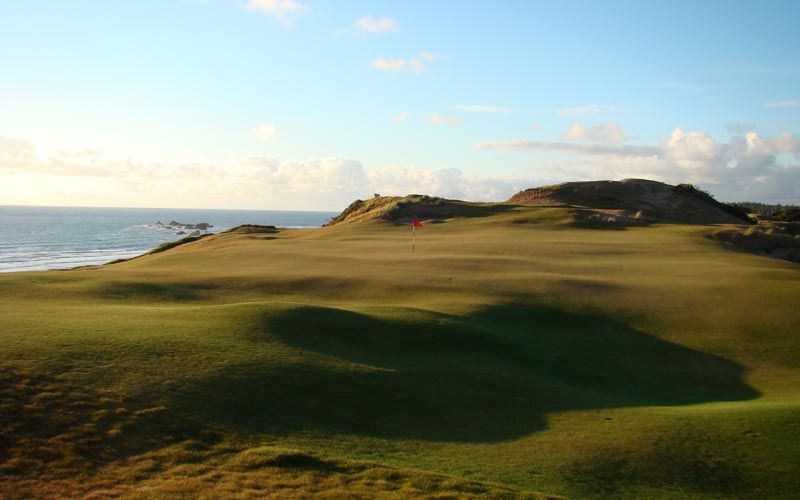
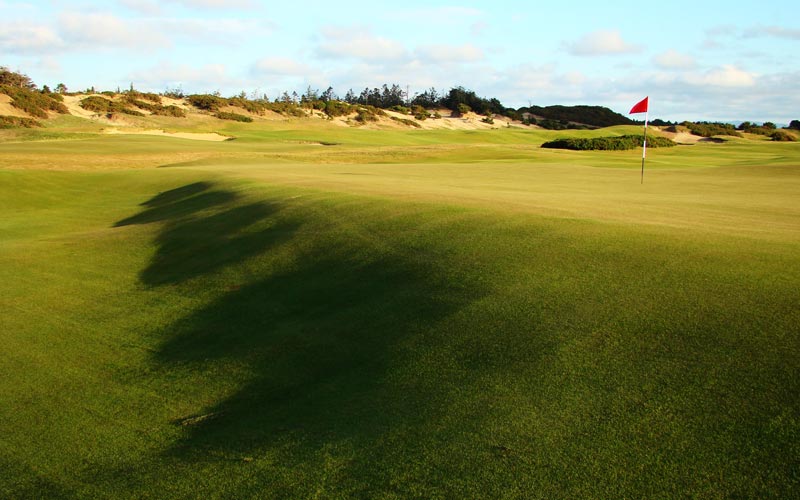


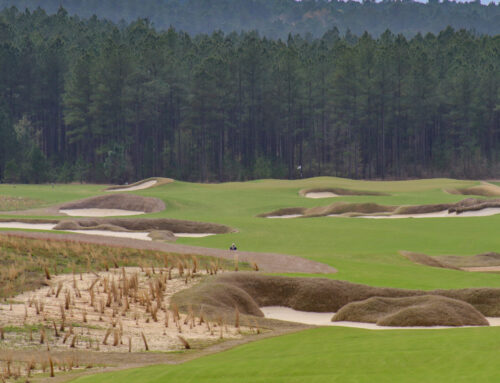


![The Park, West Palm (Lit 9) [2023]](https://golfclubatlas.com/wp-content/uploads/2024/12/IMG_7092-2-scaled-500x383.jpg)

